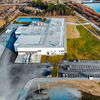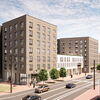Processing Your Payment
Please do not leave this page until complete. This can take a few moments.
- News
-
Editions
View Digital Editions
Biweekly Issues
- December 15, 2025
- December 1, 2025
- Nov. 17, 2025
- November 03, 2025
- October 20, 2025
- October 6, 2025
- + More
Special Editions
- Lists
- Viewpoints
-
Our Events
Event Info
Award Honorees
- Calendar
- Biz Marketplace
MEREDA panel: As Maine's population ages, senior housing needs to evolve
Expanded care, the needs of residents and the type of community are just a few of the elements that go into developing senior housing, experts said in a Thursday panel addressing the state's needs.
With the coming "silver tsunami" in a state that already has the oldest population in the country, "demand is only going to increase," said Wendy Nowokunski, cofounder and president of Northbridge Cos. She said that with investors looking for good investments, and seniors being more forthright about their needs, “this is going to open the doors for a tremendous amount of new and innovative ways to service seniors in coming years."
Nowokunski, whose company develops and operates 18 senior housing complexes in New England, joined Deb Fournier, chief operating officer of Maine Veterans' Homes, and Denise Lord, senior director of communications and planning at Maine Housing, in a MEREDA Morning Menu webinar, "Senior Housing in Maine: Today, Tomorrow and Beyond."
Maine has 250 assistant living communities, which account for 4,600 jobs, pump $410 million a year into the state's economy and generate $53 million in taxes, said Craig Young, a partner at Boulos Co., and vice president of MEREDA.
“This is definitely an economic engine, with a human element of course," said Young, who moderated the panel.
Types of senior housing include age-restricted, independent living, assisted living, memory care and skilled nursing. As the level of care needed rises, so do costs, Nowokunski said. But the focus is also on what residents of the housing want in their living space.
"What we’ve seen change is the desire for more choice, more options," Nowokunski said. She said 30 years ago, the "greatest generation" was looking for more care and having their needs met, but that's changed. "As we continue to evolve as an industry, we continue to meet those desires," she said. The focus is on quality of live, the living environment and community.
Maine Veterans' Homes 'reinventing itself'
That's exemplified in the newest Maine Veterans' Homes complex under construction in Augusta.
The 179,000-square-foot four-building complex being built by Cianbro on 44 acres on Old Belgrade Road, across the street from MaineGeneral Medical Center, is slated to open in September. It replaces the 40-year-old Cony Road building that was the organization's first.
Maine Veterans' Homes, a Augusta-based nonprofit, has six residential centers in the state and serves around 600 veterans a day. It sees the new Augusta complex as an opportunity to meet changing demands.
"We're looking to really reinvent ourselves over the next 10 years," Fournier said. "What's it gong to look like for Maine veterans?" While the senior population in the state is increasing, the number of veterans is decreasing. Fournier said, in view of that, development is moving in the direction of the "small house perspective," rather than institutional.
"We had an opportunity to have a focused approach to the new construction," she said. That not only included asking veterans and spouses what their needs were, but feedback from an architecture student in a University of Maine program that had students stay 10 days in a senior residential center.
The veterans and their families want independence, choice and autonomy, with the ability to maintain those, Fournier said. The team designing the complex came up with something that's house-like, despite being part of a larger building. Rooms are private with private bathrooms and a facade that looks like a cottage. There is a living area, den and kitchen for groups of 10 rooms, as well as a village-like area with a barbershop, bank, veterans club, ice cream store, park and children's play area for when family visits.
She said she hopes the model is one that takes off with other senior housing developers in Maine.
Looking for 'community within a community'
MaineHousing, the state's housing authority, focuses on affordable housing development, but Lord said that the needs and evolution is similar to other markets in the industry. MaineHousing, which develops housing as well as offers services to low-income homeowners and renters, has financed more than 15,000 housing units across the state.
While allowing people to age at home is ideal, many want to do it in smaller, more energy-efficient homes close to services and transportation.
"Location, the community within a community, is so important when developing adult housing," Lord said. Where that housing will be located, with access to services is important, she said. Access to broadband, too, is something "I can't stress enough," Lord said. "Use of technology has radically changed over the past 10 years, people are using it in ways never thought possible," including for necessary services.
Scale is also an issue. "At some some point, [development housing] is no longer cost effective," so looking at the community, as well as redeveloping appropriate buildings, like former schools, is key. MaineHousing uses a combination of tax credits and federal and state subsidies to bring down the cost of housing for its primary demographic, people in the $47,000-a-year income range, which is 40% to 50% of area median income.
Open space gives, takes
Nowokunski said that Maine is unique in the states her firm, Northbridge, operates in in that there is a lot of open space available to build new housing. "From a development perspective, there's an enormous amount of benefit from being able to find larger tracts of land, which we’re not able to in other parts of New England, so we’re really able to maximize open space," she said.
But Lord cautioned that developers should also keep in mind that seniors want to be near services, transportation and in a community.
She said, and the other panelists agreed, that the biggest challenge to developing more senior housing is perception.
"We need to broaden peoples' perception of what choices there are," ranging from traditional, to shared housing, accessory housing and more. "And how do we, at the local level, allow that to happen?"
She said that Maine is "still embedded in in the single-family home model."
Density and how to best use it, as well as how to best use open space, requires a new approach. If the land isn't used to its best potential, "then it isn't an option anymore."
Mainebiz web partners

The Giving Guide
The Giving Guide helps nonprofits have the opportunity to showcase and differentiate their organizations so that businesses better understand how they can contribute to a nonprofit’s mission and work.
Learn More
Work for ME
Work for ME is a workforce development tool to help Maine’s employers target Maine’s emerging workforce. Work for ME highlights each industry, its impact on Maine’s economy, the jobs available to entry-level workers, the training and education needed to get a career started.
Learn More
Groundbreaking Maine
Whether you’re a developer, financer, architect, or industry enthusiast, Groundbreaking Maine is crafted to be your go-to source for valuable insights in Maine’s real estate and construction community.
Learn more-
The Giving Guide
The Giving Guide helps nonprofits have the opportunity to showcase and differentiate their organizations so that businesses better understand how they can contribute to a nonprofit’s mission and work.
-
Work for ME
Work for ME is a workforce development tool to help Maine’s employers target Maine’s emerging workforce. Work for ME highlights each industry, its impact on Maine’s economy, the jobs available to entry-level workers, the training and education needed to get a career started.
-
Groundbreaking Maine
Whether you’re a developer, financer, architect, or industry enthusiast, Groundbreaking Maine is crafted to be your go-to source for valuable insights in Maine’s real estate and construction community.
ABOUT
NEW ENGLAND BUSINESS MEDIA SITES
No articles left
Get access now
In order to use this feature, we need some information from you. You can also login or register for a free account.
By clicking submit you are agreeing to our cookie usage and Privacy Policy
Already have an account? Login
Already have an account? Login
Want to create an account? Register
Get access now
In order to use this feature, we need some information from you. You can also login or register for a free account.
By clicking submit you are agreeing to our cookie usage and Privacy Policy
Already have an account? Login
Already have an account? Login
Want to create an account? Register







0 Comments